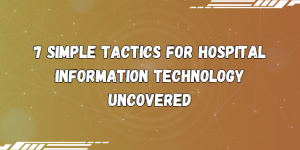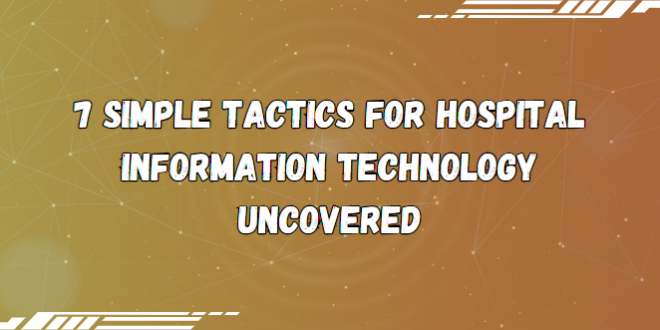Hospital Information Technology (HIT) has revolutionized the healthcare industry by transforming the way hospitals manage patient information, streamline operations, and enhance patient care. In this article, we will uncover seven simple tactics that hospitals can employ to optimize their HIT systems and improve overall efficiency.
1. Implementing Electronic Health Records (EHR)

One of the fundamental tactics for effective HIT implementation is the adoption of electronic health records. EHR systems digitize patient records, making them easily accessible to healthcare providers. This eliminates the need for manual paperwork, reduces errors, and improves information sharing among different departments within the hospital.
2. Enhancing Interoperability
Interoperability is crucial for seamless data exchange between various healthcare systems and devices. Hospitals should invest in HIT solutions that support interoperability standards, allowing different systems to communicate and share data effectively. This ensures that healthcare professionals have access to comprehensive patient information from multiple sources, leading to more informed decision-making.
3. Embracing Telehealth and Remote Monitoring
In recent years, the adoption of telehealth and remote monitoring technologies has surged. Hospitals can leverage HIT to implement telehealth services, enabling remote consultations, monitoring of chronic conditions, and post-discharge follow-ups. This tactic improves access to care, reduces hospital readmissions, and enhances patient convenience.
4. Prioritizing Data Security
Data security is of utmost importance in healthcare. Hospitals must implement robust security measures to protect patient information from unauthorized access or breaches. Tactics such as encryption, multi-factor authentication, and regular security audits should be employed to safeguard sensitive data and maintain patient trust.
5. Leveraging Data Analytics
HIT systems generate vast amounts of data. Hospitals can employ data analytics tactics to derive valuable insights from this information. By analyzing trends, patterns, and outcomes, hospitals can make data-driven decisions, optimize resource allocation, and improve patient outcomes.
6. Automating Routine Tasks
HIT can streamline and automate routine administrative tasks, such as appointment scheduling, billing, and inventory management. By implementing automation tactics, hospitals can reduce manual errors, save time, and allocate staff resources more efficiently. This allows healthcare professionals to focus on providing quality patient care.
7. Continuous Training and Education
Regular training and education for healthcare professionals are essential to maximize the benefits of HIT systems. Hospitals should provide ongoing training on the use of HIT tools, updates to the system, and best practices for data security and privacy. This tactic ensures that staff members are proficient in utilizing HIT systems to their full potential.
In Conclusion
Hospital Information Technology is revolutionizing the healthcare industry by improving patient care, streamlining operations, and enhancing overall efficiency. By implementing these seven simple tactics, hospitals can optimize their HIT systems and reap the benefits of improved data management, enhanced communication, and more informed decision-making.
Until We Meet Again
Thank you for joining us on this exploration of hospital information technology and the tactics that can optimize its implementation. We hope this article has provided valuable insights and strategies for leveraging HIT effectively. Stay tuned for more captivating articles where we unravel the secrets of healthcare technology and innovation. See you soon!
 Spacetimes A collection of the latest news and information from various trusted sources
Spacetimes A collection of the latest news and information from various trusted sources
